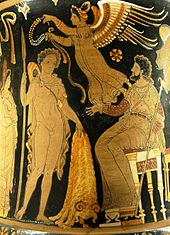Golden fleece
The golden fleece ( Greek Χρυσόμαλλον Δέρας Chrysómallon Déras ) was, according to Greek mythology, the fur of Chrysomeles , a golden ram that could fly and speak.
myth
His wife Nephele had become a stranger to the Boeotian king Athamas . That is why he took Ino , the daughter of Kadmos , as a new wife. Ino hated her stepchildren, Helle and especially the heir to the throne Phrixus , which is why she wanted to have a son of her own who would become the royal inheritance.
Nephele noticed that her children were in danger because of the stepmother's jealousy and asked the gods for help, whereupon Hermes sent Chrysomeles to her. The ram took the children on his back and carried them away. It soared in the air and flew east. As he crossed the strait that separates Europe and Asia , Helle slipped off his back and fell into the water named after her Hellespont (Sea of Light). The ram dropped Phrixus safely in Colchis , a country on the Black Sea ruled by King Aietes .
Phrixus was received there with hospitality, and in gratitude that the gods had saved his life, Chrysomeles was sacrificed in the temple of Zeus . Aietes received the valuable Golden Fleece, hung it in the sacred grove of the god Ares and had it guarded by a ship-sized dragon that never slept.
Later, the Argonauts, led by Jason and with the help of Medea , daughter of Aietes, stole Chrysomeles' fleece and brought it to Iolkos , where it was given to Pelias ( Homer : Odyssey 12.70). Stories that describe the further whereabouts of the fleece are not known.
background

The background to the myth is that sheepskins were used to wash gold dust from the rivers in the gold-rich Colchis , the area in the Caucasus in the west of today's Georgia . Excavations in Georgia brought out particularly artfully hammered gold objects from the graves of the Archaic and Classical Periods. At the Wani site , 60 km from the Black Sea, a high-class culture with numerous evidence of goldsmithing came to light as early as 1876, to a large extent during the excavations in the 1960s - including the finest fabrics made of gold thread. The height of this culture was in the 6th to 4th centuries BC. Chr.
At the latest at the beginning of the Greek colonization along the southern coast of the Black Sea in the 8th – 7th centuries. Century BC There was an oral tradition which contained the core of the Argonauts legend and must have related to the region in the east of the Black Sea. In the 8th century, a land of Kolchida was first mentioned in Greek literature , whose heyday was probably during this time.
Strabon suspected that the background to the Argonaut legend was the greed of the Greeks for the mineral resources of the Black Sea. Appian still knew in the 2nd century AD that the rivers of the Caucasus carried plenty of gold dust: "The local inhabitants hold thick woolly sheepskins in which the gold sand is caught" ( Appian : Mithridatischer Krieg, p. 103).
Aftermath
- Euripides set a special monument to Georgian gold. He had Medea's rival Glauke (Creusa), who took her husband Jason, give her a particularly precious piece of jewelry: a wonderful dress and a golden tiara. When the lucky girl put on her robe, she burned up in the fire.
- Apollonios of Rhodes tells the story of the retrieval of the Golden Fleece in the Argonautica .
- Philip the Good of Burgundy founded the " Order of the Golden Fleece " in 1430 , which became the house order of the Habsburgs .
- Pietro da Cortona made a connection between the Golden Fleece and the Lamb of God in his fresco from the 17th century of the Florentine Palazzo Pitti .
- Médée . Opera by Luigi Cherubini , 1797
- The golden fleece . Dramatic poem by Franz Grillparzer , 1819
- The golden fleece . Comic by Carl Barks , 1955
- Tintin and the secret of the golden fleece . Feature film, 1961. Book: Hergé
- Jason and the Argonauts . Feature film 1963. Director: Don Chaffey (for the time with pioneering animation technique by Ray Harryhausen )
- Medea (1969) . Feature film by Pier Paolo Pasolini , 1969
- The Argonauts. Book by Stephan Hermlin , 1974
- Medea: Voices . Book by Christa Wolf , 1996
- Jason and the battle for the Golden Fleece . Fantasy film, directed by Nick Willing, 2000
Web links
Individual evidence
- ^ Monument of Medea - a new symbol. batumi.ge, June 28, 2007
- ↑ Otar Lordkipanidze : Archeology in Georgia. From the Paleolithic to the Middle Ages. VHC, Acta Humaniora, Weinheim 1991, p. 106 f.
- ↑ Strabron: Geography I, 2, 39
- ↑ The Golden Fleecing (W US 12-02) | INDUCKS Retrieved February 17, 2020 .
